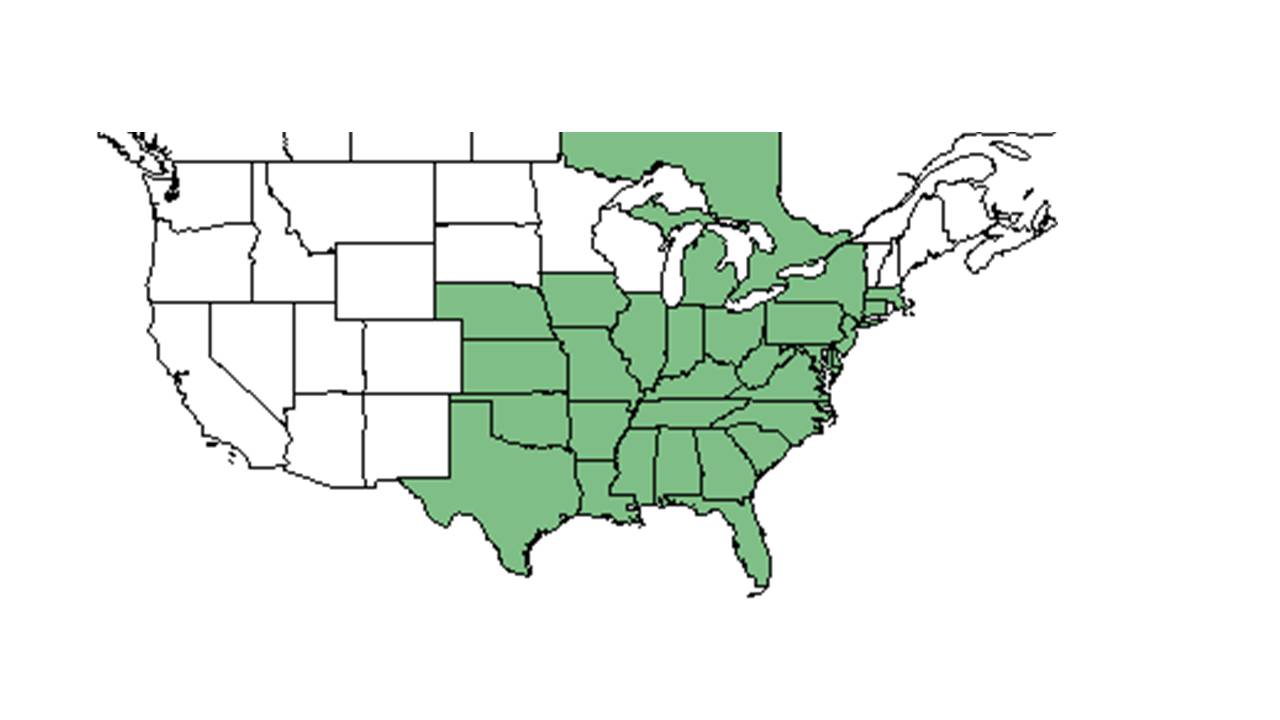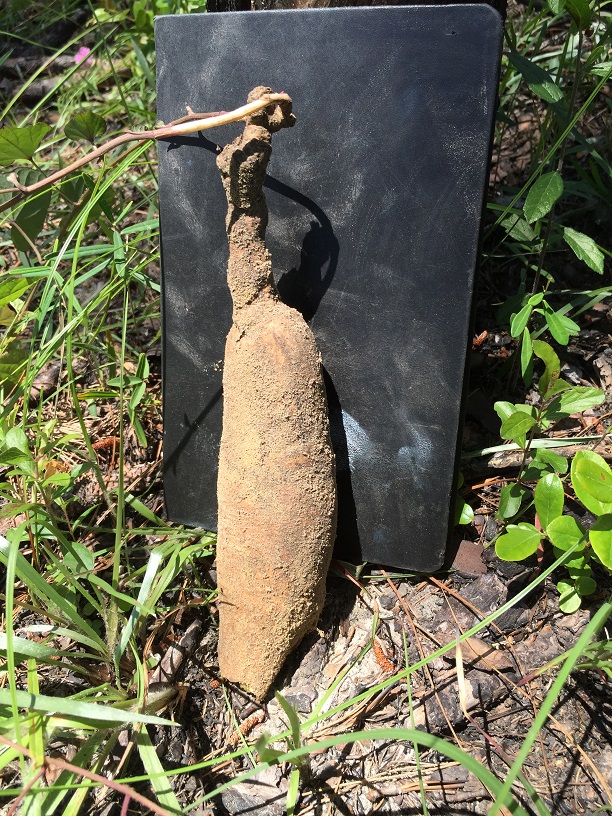Difference between revisions of "Ipomoea pandurata"
(→Conservation and Management) |
Krobertson (talk | contribs) |
||
| Line 27: | Line 27: | ||
''Ipomoea pandurata'' is a perennial trailing vine, with heart-shaped leaves, has a large storage root, and makes a new shoot every year. <ref name=free> Freeman, D. Carl, Michelle L. Brown, Jeffrey J. Duda, John H. Graham, John M. Emlen, Anthony J. Krzysik, Harold E. Balbach, David A. Kovacic, and John C. Zak. "Photosynthesis and Fluctuating Asymmetry as Indicators of Plant Response to Soil Disturbance in the Fall‐Line Sandhills of Georgia: A Case Study Using Rhus Copallinum and Ipomoea Pandurata." International Journal of Plant Sciences 165.5 (2004): 805-16. Web. 24 June 2013.</ref> This species thrives in canopy opening and in thickets. <ref name=free/> | ''Ipomoea pandurata'' is a perennial trailing vine, with heart-shaped leaves, has a large storage root, and makes a new shoot every year. <ref name=free> Freeman, D. Carl, Michelle L. Brown, Jeffrey J. Duda, John H. Graham, John M. Emlen, Anthony J. Krzysik, Harold E. Balbach, David A. Kovacic, and John C. Zak. "Photosynthesis and Fluctuating Asymmetry as Indicators of Plant Response to Soil Disturbance in the Fall‐Line Sandhills of Georgia: A Case Study Using Rhus Copallinum and Ipomoea Pandurata." International Journal of Plant Sciences 165.5 (2004): 805-16. Web. 24 June 2013.</ref> This species thrives in canopy opening and in thickets. <ref name=free/> | ||
| − | "Herbaceous annual or perennial vines, or rarely a shrubby perennial. Flowers axillary, solitary or in 2-5 flowered cymes. Calyx lobes 5, often imbricate; corolla campanulate to funnel-form, or salverform in 2 species; stamens 5, inserted in the corolla tube alternate with the lobes; stigma globose, entire or slightly lobed, style 1, ovary 2-or-4 locular. Capsule 2-4 valved; seeds 2-6, sometimes villous. A large genus of primarily tropical plants, some of which were introduced as horticultural plants and have escaped to become noxious weeds." | + | "Herbaceous annual or perennial vines, or rarely a shrubby perennial. Flowers axillary, solitary or in 2-5 flowered cymes. Calyx lobes 5, often imbricate; corolla campanulate to funnel-form, or salverform in 2 species; stamens 5, inserted in the corolla tube alternate with the lobes; stigma globose, entire or slightly lobed, style 1, ovary 2-or-4 locular. Capsule 2-4 valved; seeds 2-6, sometimes villous. A large genus of primarily tropical plants, some of which were introduced as horticultural plants and have escaped to become noxious weeds." <ref name="Radford et al 1964">Radford, Albert E., Harry E. Ahles, and C. Ritchie Bell. Manual of the Vascular Flora of the Carolinas. 1964, 1968. The University of North Carolina Press. 864-8. Print.</ref> |
| − | "Trailing, glabrate or weakly pubescent perennial from an enlarged root. Leaves ovate, entire or pandurate, 3.5-8 cm long, 2.5-8 cm wide, cordate, often pubescent beneath. Peduncles 1-5 flowered; pedicel glabrous, stout; calyx lobes coriaceous, oblong-elliptic, 12-15 mm long, glabrous, strongly imbricate; corolla campanulate, 6-8 cm long, about sa broad, the limb white, the tube lavender within; anthers 5-7 mm long, stamens and stigma included. Capsule ovoid, ca. 1 cm long; seeds villous on the angles." | + | "Trailing, glabrate or weakly pubescent perennial from an enlarged root. Leaves ovate, entire or pandurate, 3.5-8 cm long, 2.5-8 cm wide, cordate, often pubescent beneath. Peduncles 1-5 flowered; pedicel glabrous, stout; calyx lobes coriaceous, oblong-elliptic, 12-15 mm long, glabrous, strongly imbricate; corolla campanulate, 6-8 cm long, about sa broad, the limb white, the tube lavender within; anthers 5-7 mm long, stamens and stigma included. Capsule ovoid, ca. 1 cm long; seeds villous on the angles." <ref name="Radford et al 1964"/> |
==Distribution== | ==Distribution== | ||
| Line 36: | Line 36: | ||
===Habitat=== <!--Natural communities, human disturbed habitats, topography, hydrology, soils, light, fire regime requirements for removal of competition, etc.--> | ===Habitat=== <!--Natural communities, human disturbed habitats, topography, hydrology, soils, light, fire regime requirements for removal of competition, etc.--> | ||
| − | Grows in well drained uplands | + | Grows in well drained uplands. <ref name="FSU Herbarium"/> This species has also been observed to grow in open pine-oak scrub, along roadsides, and in open fields. <ref name="FSU Herbarium">Florida State University Robert K. Godfrey Herbarium database. URL: [http://herbarium.bio.fsu.edu http://herbarium.bio.fsu.edu]. Last accessed: June 2014. Collectors: Loran C. Anderson, R. F. Doren, R. Komarek, R. A. Norris, and Gwynn W. Ramsey. States and Counties: Florida: Gadsden and Leon. Georgia: Brooks, Grady, and Thomas.</ref> |
===Phenology=== <!--Timing off flowering, fruiting, seed dispersal, and environmental triggers. Cite PanFlora website if appropriate: http://www.gilnelson.com/PanFlora/ --> | ===Phenology=== <!--Timing off flowering, fruiting, seed dispersal, and environmental triggers. Cite PanFlora website if appropriate: http://www.gilnelson.com/PanFlora/ --> | ||
| − | Flowers in June | + | Flowers in June. <ref name="FSU Herbarium"/> Observed growing after a burn at the end of May/early June (Arata 1959). |
===Seed dispersal=== | ===Seed dispersal=== | ||
According to Kay Kirkman, a plant ecologist, this species disperses by gravity. <ref name="KK"> Kay Kirkman, unpublished data, 2015. </ref> | According to Kay Kirkman, a plant ecologist, this species disperses by gravity. <ref name="KK"> Kay Kirkman, unpublished data, 2015. </ref> | ||
| Line 45: | Line 45: | ||
===Fire ecology=== <!--Fire tolerance, fire dependence, adaptive fire responses--> | ===Fire ecology=== <!--Fire tolerance, fire dependence, adaptive fire responses--> | ||
| − | Observed growing after a burn at the end of May/early June. <ref name=ar> Arata, A. A. "Effects of burning on vegetation and rodent populations in a longleaf pine-turkey oak association in north central Florida." Quarterly Journal of the Florida Academy of Sciences 22 (1959): 94-104.</ref> It occurs in mostly longleaf pine communities that are annually burned as well | + | Observed growing after a burn at the end of May/early June. <ref name=ar> Arata, A. A. "Effects of burning on vegetation and rodent populations in a longleaf pine-turkey oak association in north central Florida." Quarterly Journal of the Florida Academy of Sciences 22 (1959): 94-104.</ref> It occurs in mostly longleaf pine communities that are annually burned as well. <ref name="FSU Herbarium"/> |
<!--===Pollination===--> | <!--===Pollination===--> | ||
<!--===Use by animals===--> <!--Herbivory, granivory, insect hosting, etc.--> | <!--===Use by animals===--> <!--Herbivory, granivory, insect hosting, etc.--> | ||
| Line 61: | Line 61: | ||
==References and notes== | ==References and notes== | ||
| − | |||
| − | |||
| − | |||
Revision as of 17:38, 29 July 2016
Common name: Carolina indigo
| Ipomoea pandurata | |
|---|---|

| |
| Photo taken by Gil Nelson | |
| Scientific classification | |
| Kingdom: | Plantae |
| Division: | Magnoliophyta - Flowering plants |
| Class: | Magnoliopsida – Dicotyledons |
| Order: | Solanales |
| Family: | Convolvulaceae |
| Genus: | Ipomoea |
| Species: | I. caroliniana |
| Binomial name | |
| Ipomoea pandurata (L.) G. Mey. | |

| |
| Natural range of Ipomoea pandurata from USDA NRCS Plants Database. | |
Contents
Taxonomic notes
Synonyms: Ipomoea pandurata var. pandurata; I. pandurata var. rubescens Choisy
Description
Ipomoea pandurata is a perennial trailing vine, with heart-shaped leaves, has a large storage root, and makes a new shoot every year. [1] This species thrives in canopy opening and in thickets. [1]
"Herbaceous annual or perennial vines, or rarely a shrubby perennial. Flowers axillary, solitary or in 2-5 flowered cymes. Calyx lobes 5, often imbricate; corolla campanulate to funnel-form, or salverform in 2 species; stamens 5, inserted in the corolla tube alternate with the lobes; stigma globose, entire or slightly lobed, style 1, ovary 2-or-4 locular. Capsule 2-4 valved; seeds 2-6, sometimes villous. A large genus of primarily tropical plants, some of which were introduced as horticultural plants and have escaped to become noxious weeds." [2]
"Trailing, glabrate or weakly pubescent perennial from an enlarged root. Leaves ovate, entire or pandurate, 3.5-8 cm long, 2.5-8 cm wide, cordate, often pubescent beneath. Peduncles 1-5 flowered; pedicel glabrous, stout; calyx lobes coriaceous, oblong-elliptic, 12-15 mm long, glabrous, strongly imbricate; corolla campanulate, 6-8 cm long, about sa broad, the limb white, the tube lavender within; anthers 5-7 mm long, stamens and stigma included. Capsule ovoid, ca. 1 cm long; seeds villous on the angles." [2]
Distribution
Ecology
It was observed that I. pandurata’s growth in recently burned areas is low but in areas that are unburned and have low disturbance have higher growth rates. [1]
Habitat
Grows in well drained uplands. [3] This species has also been observed to grow in open pine-oak scrub, along roadsides, and in open fields. [3]
Phenology
Flowers in June. [3] Observed growing after a burn at the end of May/early June (Arata 1959).
Seed dispersal
According to Kay Kirkman, a plant ecologist, this species disperses by gravity. [4]
Fire ecology
Observed growing after a burn at the end of May/early June. [5] It occurs in mostly longleaf pine communities that are annually burned as well. [3]
Conservation and management
Cultivation and restoration
Photo Gallery
References and notes
- ↑ 1.0 1.1 1.2 Freeman, D. Carl, Michelle L. Brown, Jeffrey J. Duda, John H. Graham, John M. Emlen, Anthony J. Krzysik, Harold E. Balbach, David A. Kovacic, and John C. Zak. "Photosynthesis and Fluctuating Asymmetry as Indicators of Plant Response to Soil Disturbance in the Fall‐Line Sandhills of Georgia: A Case Study Using Rhus Copallinum and Ipomoea Pandurata." International Journal of Plant Sciences 165.5 (2004): 805-16. Web. 24 June 2013.
- ↑ 2.0 2.1 Radford, Albert E., Harry E. Ahles, and C. Ritchie Bell. Manual of the Vascular Flora of the Carolinas. 1964, 1968. The University of North Carolina Press. 864-8. Print.
- ↑ 3.0 3.1 3.2 3.3 Florida State University Robert K. Godfrey Herbarium database. URL: http://herbarium.bio.fsu.edu. Last accessed: June 2014. Collectors: Loran C. Anderson, R. F. Doren, R. Komarek, R. A. Norris, and Gwynn W. Ramsey. States and Counties: Florida: Gadsden and Leon. Georgia: Brooks, Grady, and Thomas.
- ↑ Kay Kirkman, unpublished data, 2015.
- ↑ Arata, A. A. "Effects of burning on vegetation and rodent populations in a longleaf pine-turkey oak association in north central Florida." Quarterly Journal of the Florida Academy of Sciences 22 (1959): 94-104.

